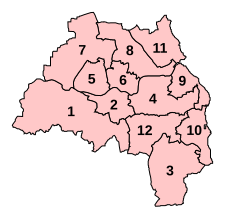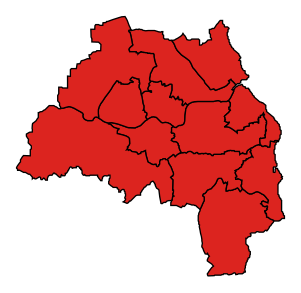Top Qs
Timeline
Chat
Perspective
Parliamentary constituencies in Tyne and Wear
From Wikipedia, the free encyclopedia
Remove ads
The ceremonial county of Tyne and Wear is divided into 13 parliamentary constituencies, including 2 cross-county boundary seats with Northumberland and one with Durham, of which 9 are borough constituencies and 4 county constituencies. As of the 2024 general election, all 13 are represented by the Labour Party.
Constituencies
Remove ads
Boundary changes
Summarize
Perspective
2024
See 2023 review of Westminster constituencies for further details.
For the 2023 review of Westminster constituencies, which redrew the constituency map ahead of the 2024 general election, the Boundary Commission for England opted to combine Newcastle upon Tyne and North Tyneside with Northumberland as a sub-region of the North East Region, with the creation of two cross-county boundary constituencies comprising an expanded Hexham seat and a new seat named Cramlington and Killingworth. Gateshead, South Tyneside and Sunderland would be combined with County Durham, resulting in another cross-county boundary constituency, named Blaydon and Consett. The constituencies names of Blaydon, Gateshead, Jarrow, North Tyneside, Newcastle upon Tyne Central, Newcastle upon Tyne East, and Washington and Sunderland West were abolished, and new or re-established constituency names of Gateshead Central and Whickham, Jarrow and Gateshead East, Newcastle upon Tyne Central and West, Newcastle upon Tyne East and Wallsend, and Washington and Gateshead South created.[1][2]
The following seats resulted from the boundary review:
Containing electoral wards from Gateshead
- Blaydon and Consett (part)
- Gateshead Central and Whickham
- Jarrow and Gateshead East (part)
- Washington and Gateshead South (part)
Containing electoral wards from Newcastle upon Tyne
- Cramlington and Killingworth (parts also in North Tyneside and Northumberland)
- Hexham (part also in Northumberland)
- Newcastle upon Tyne Central and West
- Newcastle upon Tyne East and Wallsend (part)
- Newcastle upon Tyne North (part)
Containing electoral wards from North Tyneside
- Cramlington and Killingworth (parts also in Newcastle upon Tyne and Northumberland)
- Newcastle upon Tyne East and Wallsend (part)
- Newcastle upon Tyne North (part)
- Tynemouth
Containing electoral wards from South Tyneside
- Jarrow and Gateshead East (part)
- South Shields
Containing electoral wards from Sunderland
- Houghton and Sunderland South
- Sunderland Central
- Washington and Gateshead South (part)
2010
Under the Fifth Periodic Review of Westminster constituencies, the Boundary Commission for England decided to reduce the number of seats in Tyne and Wear from 13 to 12, leading to significant changes. The constituencies of Gateshead East and Washington West, Houghton and Washington East, Sunderland North, Sunderland South, and Tyne Bridge were abolished and replaced with Gateshead, Houghton and Sunderland South, Sunderland Central, and Washington and Sunderland West. Newcastle upon Tyne East and Wallsend became Newcastle upon Tyne East.
Remove ads
Results history
Summarize
Perspective
Primary data source: House of Commons research briefing - General election results from 1918 to 2019[3]
2024
The number of votes cast for each political party who fielded candidates in constituencies comprising Tyne and Wear in the 2024 general election were as follows:[nb 3]
Percentage votes
11983 & 1987 - Alliance
* Included in Other
Seats
Maps
1983 to 2024
- 1983
- 1987
- 1992
- 1997
- 2001
- 2005
- 2010
- 2015
- 2017
- 2019
2024 to present (including three cross-county constituencies)
- 2024
Historical representation by party
Summarize
Perspective
1983 to 2010
2010 to present
1includes areas of County Durham
2parts transferred in 2024 to the seat of Cramlington & Killingworth which is mostly in Northumberland
Remove ads
See also
Notes
- BC denotes borough constituency, CC denotes county constituency.
- The majority is the number of votes the winning candidate receives more than their nearest rival.
- Vote shares include the cross-county constituencies of Blaydon and Consett and Cramlington and Killingworth which have roughly evenly split electorates between Tyne and Wear and County Durham and Northumberland respectively. Vote shares exclude Hexham which has a majority Northumberland electorate
Remove ads
References
Wikiwand - on
Seamless Wikipedia browsing. On steroids.
Remove ads




















